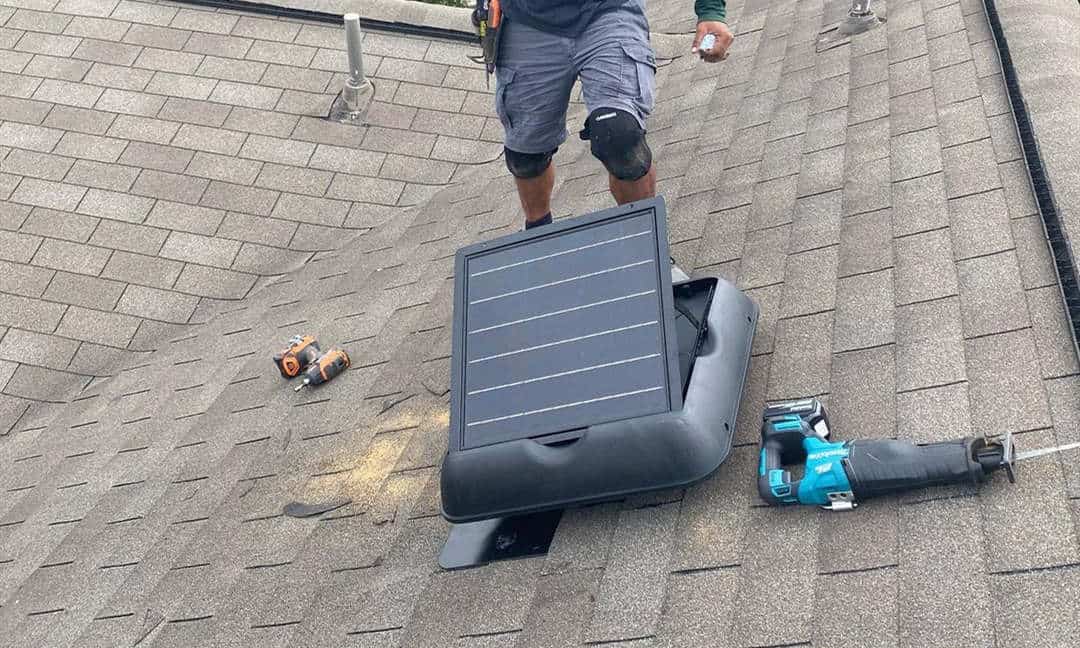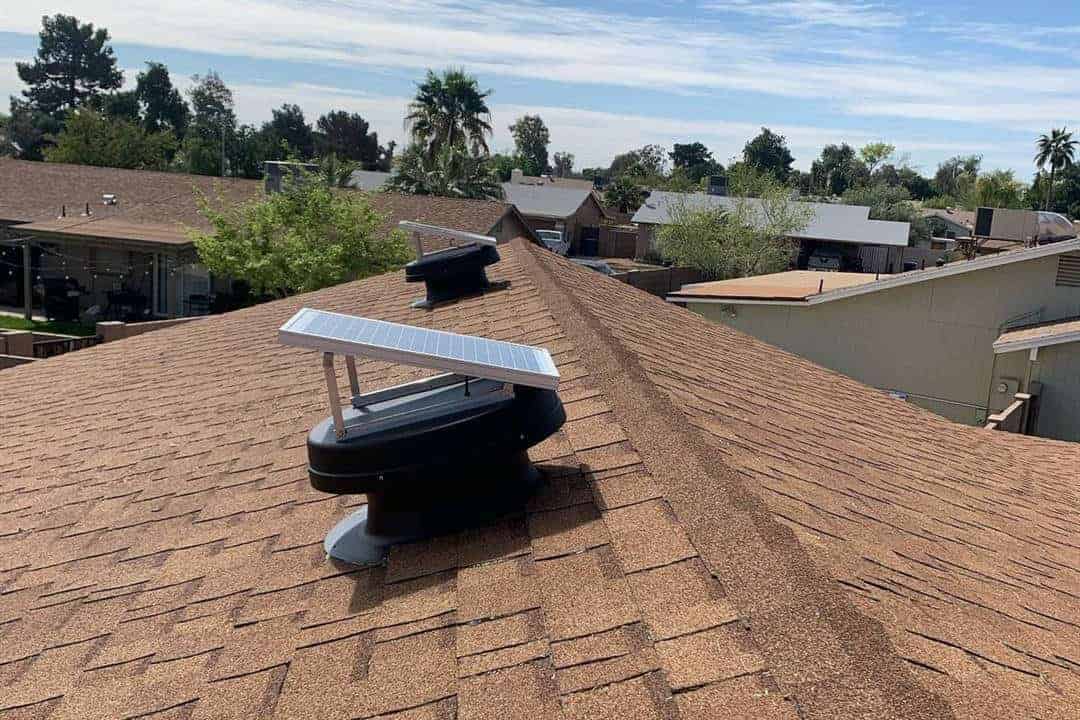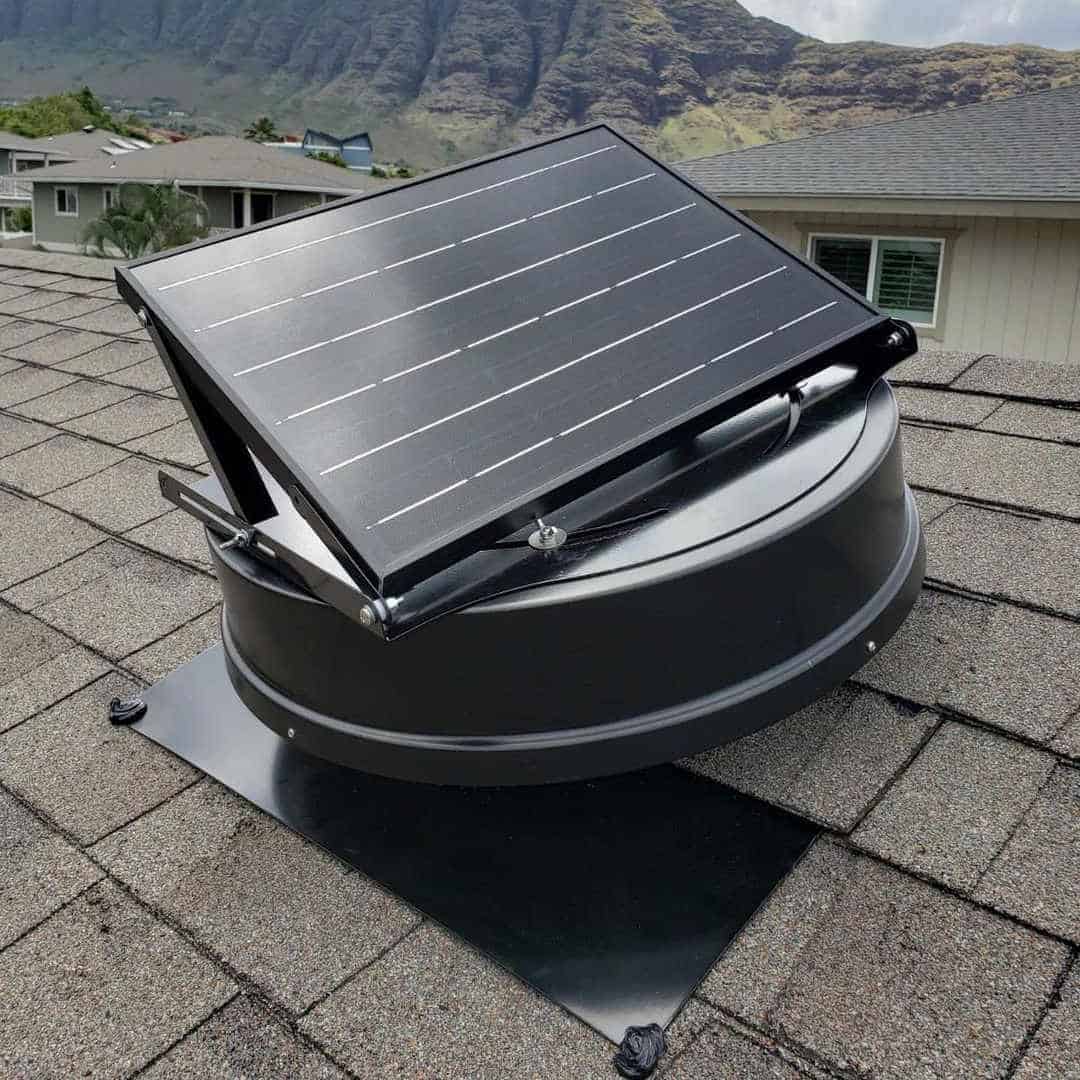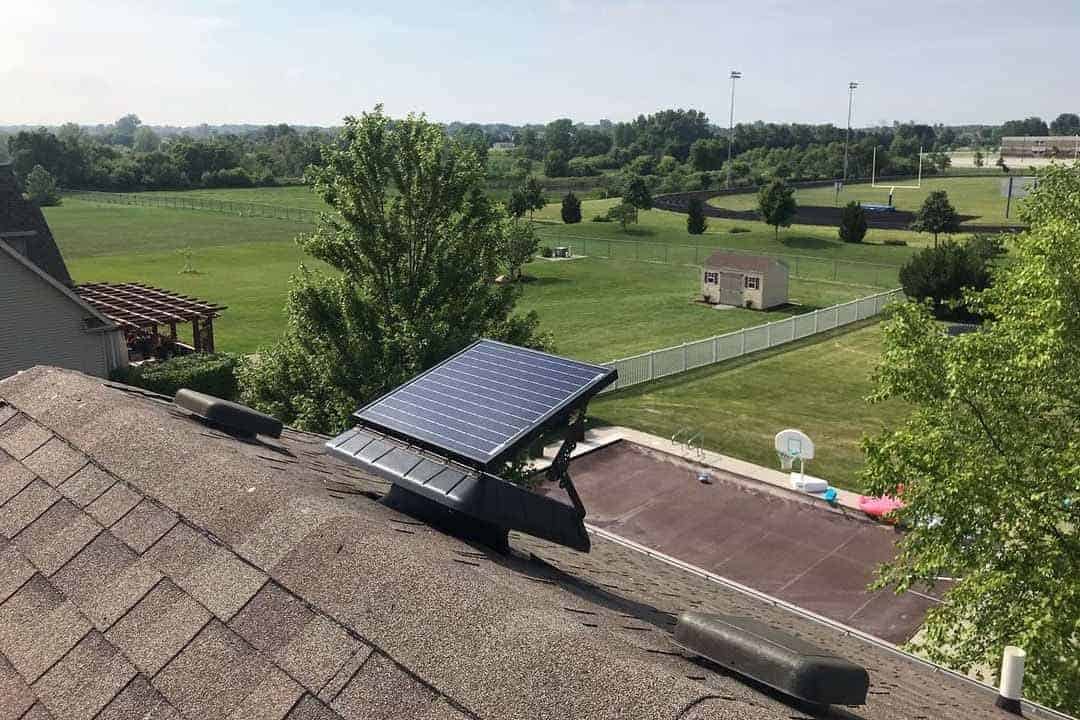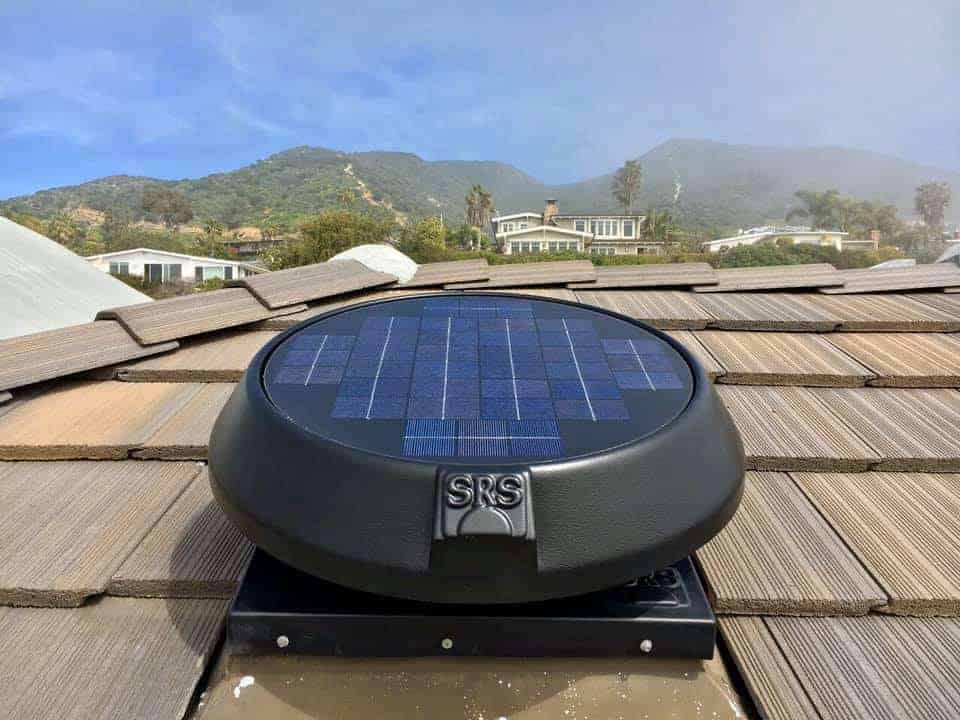Do you find it difficult to keep your house cool during the hot summer months? I certainly do, and my summer electricity bills aren’t much fun, what with all the cost of running my AC units. But fear not, I’ve got a great way to keep your house cool without adding to your energy bills. Want to know more?
One significant factor contributing to your house getting so hot in the summer can be your attic. In hot months, the air in your attic can heat up to temperatures of 120°F or more. This pocket of scorching air transfers heat through your ceilings into your house.
It’s a constant battle between your cooling system and the hot air in your attic. Now I’m going to show you how to change all that with a solar attic fan installation.
What is a solar attic fan and why do you need one?
An attic fan is a ventilation system that lowers the temperature in your attic by venting out hot air and bringing in cooler air through. When this cool air lowers the temperature in your attic, less heat is transferred through your roof to your home, reducing the temperature and your air-con’s workload.
How does a solar attic fan work?
You don’t need your solar attic fan to run all the time. The time you need assistance from a solar fan is when direct sunlight shines onto your roof tiles, heating the space below.
Luckily, when the sun is shining, the solar panel that powers your solar fan starts to convert sunlight into electricity. Direct sunlight hits the solar panel and produces electricity through a chemical reaction known as the photovoltaic effect. We don’t need to get into the details here; all you need to know is that a solar attic fan operates under direct (and sometimes indirect) sunlight so it works when it’s needed most.
Are solar attic fans any use in winter?
Solar attic fans are a very effective way to cool your home during the hot summer months, but does this mean they are of no use the rest of the year?
In fact, solar attic fans can do an excellent job year-round. Here’s why.
The reason most homes are built with some loft ventilation is that it’s healthy for your attic to have airflow year-round. This is to prevent problems caused by the buildup of moisture in your attic. A good airflow makes sure that you avoid issues like condensation, mildew, and damp patches.
Ice damming is another problem that affects roofs in winter. Meltwater gets into the eaves of your roof and re-freezes. An ice buildup passes back through the shingles of your roof and then melts in your attic causing water to leak onto your ceilings.
What are the different types of attic fans?
Some attic fan systems connect to your mains electricity supply. These are useful, but I won’t look at them here. This is because mains-connected attic fans have an ongoing electricity cost, and we want our fans to work for free, right? So I’ll just explain how to install solar attic fans.
How to install solar attic fans
Installing solar fans is relatively straightforward, but there are a few things that you need to look out for to make sure that you put them in the right place and get them to work as intended. Don’t worry, there’s nothing too technical, and we will go through it all point by point below.
1) Make sure you have attic ventilation
Your solar fan will then hot air out of your attic, so what’s going to replace that air? Most lofts have ventilation points at the eaves of your roof, in the bottom corner. This is called soffit ventilation. Before installing your fans, you need to make sure that your attic has this ventilation to draw in cooler air when the fan expels the hot air.
A good guideline is to make sure that you have 4 ft² feet of soffit ventilation per fan. If your soffit ventilation is protected by a grill or cover, then you should double this to 8 ft² per fan.
2) Grounding is important
Your solar fan contains metal, and you’re putting it on your roof. One word, lightning. To protect you in the event of a lightning strike, your solar fans need to be grounded. Your solar fan should contain a grounding wire; you just need to ensure this is connected correctly. This is easy to do, but it’s very important.
3) Make sure that your attic is sealed off from your house
Some people suggest that solar attic fans do more harm than good by drawing up cool air-conditioned air from your house, increasing the workload on your home cooling system. And, you know what, this can be true sometimes.
It’s easy to prevent this from happening, though. You just need to make sure that there is an airtight barrier between your home and your attic. You should check the seal on your attic access to ensure that it is airtight, and this will prevent that precious cool air from being drawn up from your house.
4) Where on your roof should you place your attic fan?
Since the USA is in the northern hemisphere, solar panels that point South receive the most sunlight. So ideally, you want to place your solar fan on a south-facing roof slope. If this isn’t convenient, then you should buy solar fans with tiltable solar panels. A tiltable panel Gives you the flexibility to put your solar fan on an east or west-facing roof and then angle it towards the south.
Ideally, you should put your solar fans in a central part of your roof. This will enable an even airflow of cooler air from Your roof’s soffit ventilation.
How many solar attic fans do I need?
You need two pieces of information to work out how many solar roof fans you will need. Let’s go through it step-by-step; it’s pretty simple.
What is your roof area?
If you don’t have this figure readily available, a rough estimation of your roof area can be made by calculating the square footage of one story of your house. For a more accurate measurement, you may need to consider other factors such as roof overhangs and roof shape.
What is your roof slope?
Perhaps you already know the slope of your roof? It will be in your house plans if you have those. The pitch is measured in twelfths.
A shallow roof might have a slope of 2/12, and a steep one could be 8/12. The first number is the rise (vertical height), and the second number is the run (horizontal distance).
Once you have this information, you can figure out how many solar fans you need by looking at the tables below.
Guide for roofs with a low slope
| Attic Slope | Attic Size | Attic Fan Size in Watts |
| 1/12 – 4/12 | 800 ft² | 1 Solar Attic Fan |
| 1/12 – 4/12 | 1,200 ft² | 1 Solar Attic Fans |
| 1/12 – 4/12 | 1,600 ft² | 2 Solar Attic Fans |
| 1/12 – 4/12 | 2,000 ft² | 2 Solar Attic Fans |
| 1/12 – 4/12 | 2,400 ft² | 3 Solar Attic Fans |
Guide for roofs with medium slope
| Attic Slope | Attic Size | Attic Fan Size in Watts |
| 5/12 – 8/12 | 800 ft² | 1 Solar Attic Fan |
| 5/12 – 8/12 | 1,200 ft² | 2 Solar Attic Fans |
| 5/12 – 8/12 | 1,600 ft² | 2 Solar Attic Fans |
| 5/12 – 8/12 | 2,000 ft² | 3 Solar Attic Fans |
| 5/12 – 8/12 | 2,400 ft² | 4 Solar Attic Fans |
Guide for roofs with a high slope
| Attic Slope | Attic Size | Attic Fan Size in Watts |
| 9/12 – 12/12 | 800 ft² | 2 Solar Attic Fans |
| 9/12 – 12/12 | 1,200 ft² | 2 Solar Attic Fans |
| 9/12 – 12/12 | 1,600 ft² | 3 Solar Attic Fans |
| 9/12 – 12/12 | 2,000 ft² | 4 Solar Attic Fans |
| 9/12 – 12/12 | 2,400 ft² | 5 Solar Attic Fans |
Note that these numbers are guidelines based on 20W fans in regular attic conditions.
Installing your attic fans
Now you have all the information you need about what solar attic fans to buy and where to install them. If you are a keen home improver, then you could do the installation yourself. Alternatively, any competent professional can do the job for you. Just make sure that you agree on the following things with them:
- The position of the solar fans
- The angle of tilt of the solar panels
- Confirm that the panels are grounded
A quick recap
Now you understand the benefits of solar fans and how they can save you money by cooling your home, you can go ahead with your solar fan installation. All you need to do is follow the point-by-point process below to be sure of installing the correct solar fans in the right place and benefiting from the energy savings.
- Make sure you have good attic soffit ventilation. Remember you need 4-8 ft² per fan
- Always make sure your solar attic fans are grounded for safety from lightning strikes
- Make sure that your attic well sealed off from your house
- Place your solar attic fans on a south-facing slope where possible or angle tiltable solar panels towards the south
- Place your solar fans in a central position on your roof
- Calculate how many solar fans, at what power you need.
- Buy your solar attic fans
- Install the fans and start enjoying their benefits
If you have any questions or comments about solar attic fan installation, please share them with us below.

